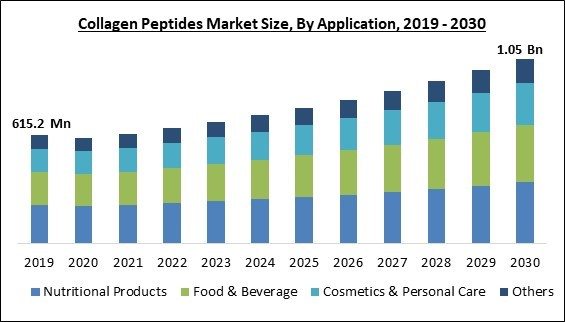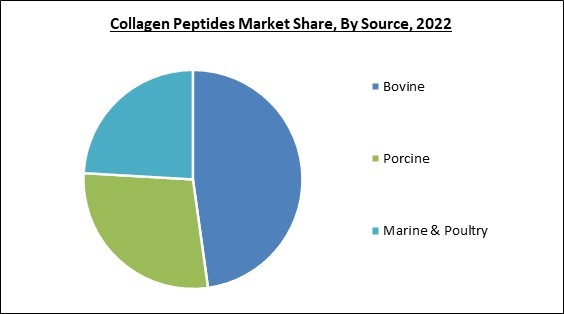The skin's collagens maintain skin structure. The collagen fibers in human skin suffer damage over time, losing thickness and strength, which causes the skin to age. The Cosmetics & Personal Care segment will register around 23% share in the market by 2030. Products for personal care and cosmetics employ collagen peptides. They are utilized as nutritional supplements for the bones and are available as lotions. In addition, they are used for soft skin augmentation and skin replacement. They appear in various personal care items, including soaps, shampoos, body lotions, and facial creams. Some sunscreens and sunblock products incorporate collagen to help protect the skin from the damaging effects of UV radiation while also providing anti-aging benefits. Some of the factors impacting the market are technological improvements in collagen production and extraction, promotion of a healthy diet by Government, and cultural prohibitions on the consumption of products derived from animals.
Traditional techniques for removing collagen from animal sources, including boiling or acid treatment, have been improved and optimized. Enzymatic hydrolysis is used in modern extraction methods to break down collagen into smaller peptides. This process is more efficient and produces collagen peptides of greater quality. Because of technological and manufacturing advancements, extracting these from numerous sources is simpler and more effective. Additionally, they have helped expand the spectrum of products, including collagen peptides, and fueled market expansion. Moreover, Governments around the world have implemented various initiatives to promote healthy food consumption and combat issues like obesity, diet-related diseases, and malnutrition. These initiatives often involve a combination of policy measures, public awareness campaigns, and regulatory changes. Consumers consume a lot of nutritional meals and dietary supplements that use hydrolyzed collagen in various ways. Government programs promoting a healthy lifestyle would raise the demand for these products, thus immediately impacting this market.
However, the collagen from slaughtered animals, such as the hoovers, hides, and bones of cattle, poultry, fish, and pigs, is converted into collagen peptides, which are animal byproducts. Religious restrictions prevent the consumption of some animals in certain regions of the world. Kosher regulations prohibit the consumption of pigs and items made from pigs. These cultural and regional outlooks may limit the market growth throughout the forecast period.
Application Outlook
On the basis of application, the market is classified into food & beverage, nutritional products, cosmetics & personal care, and others. In 2022, the nutritional products segment registered the highest revenue share in the market. This is because it offers health benefits. Dietary supplements and sports nutrition are two examples of applications for nutritional products. It has been shown that collagen peptides are a valuable dietary supplement for maintaining the tendons and ligaments of athletes, encouraging high performance, and accelerating the return to training. This nutritional therapy also helps athletes return to play and function at their prior level more quickly and safely by treating tendon and ligament problems, such as overuse injuries.Source Outlook
By source, the market is segmented into bovine, porcine, and marine & poultry. The porcine segment acquired a substantial revenue share in the market in 2022. This meat is widely consumed, easily accessible, and reasonably priced. Functional pork collagen proteins benefit from better water binding, finer texture, less syneresis, better emulsifying ability, and superior organoleptic features. Additionally, they assist with nutrition because they are a crucial source of energy for the growth of cells and maintenance. Due to the health and aesthetic benefits, these are highly demanded, particularly among women.Form Outlook
Based on form, the market is fragmented into dry and liquid. In 2022, the dry segment held the highest revenue share in the market. Collagen peptide is available in agglomerated or fine powder form in the dry form. Due to its fast solubility, these are used in various industries. Collagen peptides in powder form have excellent blending qualities. These can be used in multiple food products, such as coffee, smoothies, dairy goods, snacks, soups, and sauces.Regional Outlook
Region-wise, the market is analysed across North America, Europe, Asia Pacific, and LAMEA. In 2022, the Europe region witnessed the largest revenue share in the market. High consumer awareness of health is one of the reasons for the high demand of the market in the European region. The region also has a well-established, highly innovative cosmetics and personal care products sector in France and other European nations. Additionally, Europe is one of the critical continents in the pharmaceutical industry. Thus, these are extensively utilized in biomedical applications.The market research report covers the analysis of key stakeholders of the market. Key companies profiled in the report include Tessenderlo Group NV, Gelita AG, Darling Ingredients, Inc., Nitta Gelatin, Inc., BioCell Technology LLC, Lapi Gelatine S.p.a (Lapi Group), SAS Gelatines Weishardt, Viscofan, S.A., Amicogen Co., Ltd., and Foodmate Co., Ltd. (Foodchem Group)
Scope of the Study
By Application(Volume, Tonnes, USD Million, 2019-2030)
- Nutritional Products
- Food & Beverage
- Cosmetics & Personal Care
- Others
By Source(Volume, Tonnes, USD Million, 2019-2030)
- Bovine
- Porcine
- Marine & Poultry
By Form
- Liquid
- Dry
By Geography(Volume, Tonnes, USD Million, 2019-2030)
- North America
- US
- Canada
- Mexico
- Rest of North America
- Europe
- Germany
- UK
- France
- Russia
- Spain
- Italy
- Rest of Europe
- Asia Pacific
- China
- Japan
- India
- South Korea
- Singapore
- Malaysia
- Rest of Asia Pacific
- LAMEA
- Brazil
- Argentina
- UAE
- Egypt
- South Africa
- Nigeria
- Rest of LAMEA
Key Market Players
List of Companies Profiled in the Report:
- Tessenderlo Group NV
- Gelita AG
- Darling Ingredients, Inc.
- Nitta Gelatin, Inc.
- BioCell Technology LLC
- Lapi Gelatine S.p.a (Lapi Group)
- SAS Gelatines Weishardt
- Viscofan, S.A.
- Amicogen Co., Ltd.
- Foodmate Co., Ltd. (Foodchem Group)
Unique Offerings
- Exhaustive coverage
- The highest number of Market tables and figures
- Subscription-based model available
- Guaranteed best price
- Assured post sales research support with 10% customization free
Table of Contents
Companies Mentioned
- Tessenderlo Group NV
- Gelita AG
- Darling Ingredients, Inc.
- Nitta Gelatin, Inc.
- BioCell Technology LLC
- Lapi Gelatine S.p.a (Lapi Group)
- SAS Gelatines Weishardt
- Viscofan, S.A.
- Amicogen Co., Ltd.
- Foodmate Co., Ltd. (Foodchem Group)










